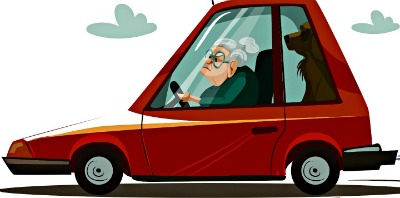13 Reasons Faculties Diminish as Drivers Age
 By Aubrey Cohen
By Aubrey Cohen
An aging population of baby boomers means more and more older drivers will be on the road in coming years, and that brings special safety concerns.
People over age 50 made up a record 44 percent of all drivers in 2013, according to the Federal Highway Administration. The number of drivers over age 65 is projected to rise by 77 percent by 2045.
The number of fatal and non-fatal crashes per mile driven starts rising around age 70, the Insurance Institute for Highway Safety reports, although it notes that this statistic may be somewhat inflated because older drivers do a higher share of their driving in cities, where more crashes occur.
Older people often have deterioration in many faculties that relate to safe driving, according to a newly published study in the Journal Public Health Nursing.
“Driving is arguably one of the most complex procedures humans engage in on a routine basis,” the study says.
Seniors also tend to be more frail than other drivers, making any accident more likely to result in injury or death.
As drivers age, it’s important for them to understand potential impairments and what they can do about them. Major driving-related functions that can deteriorate with age, according to the new paper, fall into the categories of executive functioning, visual mechanisms, memory and insight.
Here are details on each:
Executive function
1. Attention refers to three things here:
- Selective attention, the ability to distinguish and focus on areas of importance, and block out distractions;
- Divided attention, the ability to focus on two or more stimuli, such as driving forward, and checking beside and behind you while changing lanes; and
- Sustained attention, staying alert for a long period.
Studies cited in the Public Health Nursing report found older drivers often have trouble focusing on important stimuli and ignoring irrelevant information.
2. Cognitive flexibility is the ability to quickly respond to new input, such as changing strategies while driving.
3. Hazard perception is the ability to anticipate potentially dangerous situations.
Visual mechanisms
4. Visual acuity can decline with age due to eye disease, cloudiness and yellowing, alterations in macular pigment and neural integrity, and decreased pupil size.
5. Useful field of view refers to visual function and attention, determining whether a driver can detect peripheral threats while simultaneously seeing what is directly in front of them. Older drivers with poor useful field of view have been shown to be much more likely to make blind-spot errors.
6. Visual processing speed can slow due to age-related changes to the eyes, meaning older drivers may not be able to react quickly enough to avoid a crash.
7. Visual perception refers to accurate interpretation of visual information, allowing drivers to read traffic signs, orient themselves to traffic and maintain their course.
8. Visuospatial skills involve perception of depth and lane alignment, and passing ability.
9. Visuomotor skills rely on hand-eye coordination.
Studies visuospatial and visuomotor skills correlate most strongly with poor driving by older adults.
Memory
10. Procedural memory is the ability to use a learned skill — like starting the car, changing gears and pressing the correct pedal — without thinking about it;
11. Episodic memory includes remembering your destination and how to get there, what the speed limit is and whether you entered a school zone; and
12. Semantic memory allows us to interpret the meaning of things like recently passed road signs and what colors mean on traffic lights.
Insight
13. Many people overrate their driving skills, but this can be a particular problem for older people whose abilities are declining. Studies have shown that seniors remain confident in their abilities to handle potentially hazardous driving situations regardless of their cognitive decline. Those with bigger differences between their perceived and actual abilities are less less likely to self-regulate their driving, according to the new paper.

Driving safely as we age
The good news is that the number of people 70 and over who died in car crashes fell by 29 percent from a peak in 1997 to 2014, despite a 27 percent increase in the older population during this period, according to the IIHS.
Fatal and non-fatal crash rates have been declining faster among older drivers than those aged 35 to 54.
Some of this is thanks to safer cars, with features like automatic braking to avoid collisions, and road improvements that can be particularly helpful to older drivers, such making highway signs and lane markings brighter, adding left-turn arrows at intersections, so drivers don’t have to judge when it’s safe to turn, and replacing intersections with roundabouts.
As for older drivers themselves, many do self-regulate, says Russ Rader, senior vice president for communication at the Insurance Institute for Highway Safety. “We see that older drivers who have declining vision, for example, may drive less at night.”
Here are some other ways older drivers can help stay safe while driving, according to the National Institutes of Health.
- Vision: Have your vision checked every year or two, avoid driving at night if you have trouble seeing in the dark, keep your windshield, mirrors and lights clean, and turn up the brightness of your instrument panel.
- Hearing: Have your hearing checked every three years, keep in the inside of the car as quiet as possible and watch for flashing lights of emergency vehicles, since you might not hear them.
- Attention and reaction time: Leave ample space between you and the car in front of you (a good measure is to ensure you can count slowly to four between when that car passes an object along the road and you pass the same object), start braking early when you need to stop, avoid high-traffic areas and times, stay to the right on highways and avoid left turns.
- Physical changes: Ask your doctor about pain or stiffness gets in the way of driving, and exercise — it can improve flexibility, coordination and speed, and reduce driving errors.
- Medications: Read medication labels for warnings related to driving and talk to your doctor or pharmacist about any potential problems, and don’t drive if you feel lightheaded or drowsy, or mixed drinking with medications.
The NIH also recommends taking a defensive driving class. This may provide a financial benefit, as many insurance companies provide a discount to seniors to take such a class.
One policy that can help seniors stop driving is requiring them to come into a state office to renew their licenses, Rader adds.
“We think it’s because older drivers who recognize their own impairments and are worried about failing the test simply give up their licenses.”
